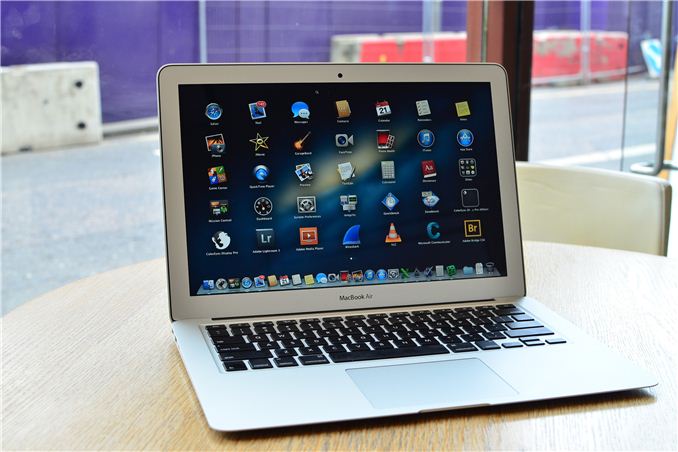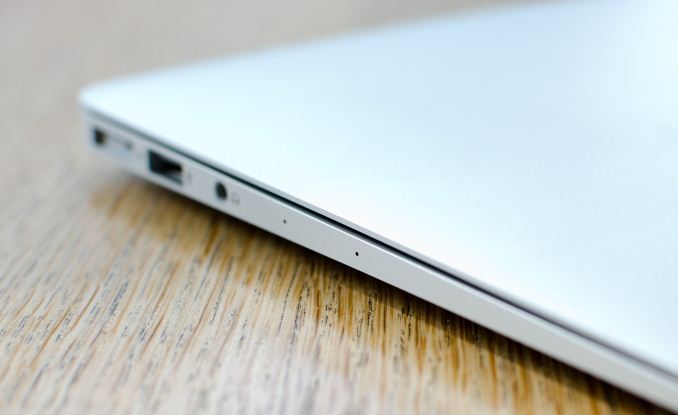The 2013 MacBook Air Review (13-inch)
by Anand Lal Shimpi on June 24, 2013 12:01 AM EST
Things didn’t go exactly as I’d expected at WWDC. I spent the week before the show at Computex, talking to PC OEMs, who had all just launched their Haswell ULT based Ultrabooks. With a couple of exceptions however, the bulk of Haswell ULT systems weren’t scheduled to ship until later this year. Even the Acer S7 I snagged while in Taipei was still a pre-production unit, with final hardware due out in the next month. Based on what I saw in Taiwan, and Intel having seeded me an Iris Pro machine the week before, I assumed that the MacBook Pro with Retina Display is what would get the Haswell treatment first. Obviously, that didn’t happen.
In hindsight, the move makes sense. Apple will sell far more MacBook Airs than rMBPs. The Apple/Intel relationship is looking very healthy these days, so it’s also not surprising that it would have supply and early enough access to Haswell ULT to launch the MBAs at WWDC with almost immediate availability. The Haswell ULT shift didn’t require a new chassis for Apple, which meant a less complex development process.
From the outside, the new MacBook Air looks nearly identical to its predecessor. There's a second mic opening on the left side of the machine now, but otherwise you'd be hard pressed to tell this year's model apart from the previous generation. Internally, nearly everything has changed.
The battery is higher capacity, with no increase in weight. Making better use of that larger battery is Intel's new Haswell ULT silicon. Since we're talking about a ULT part, the PCH moves from the motherboard to the CPU package - creating an emptier motherboard than we've seen in previous years:
The 2013 13-inch MacBook Air Motherboard, Courtesy iFixit
It's clear to me that the MBA is due for a more significant redesign, but this is not the year for that.
Alongside Haswell comes a brand new PCIe SSD, 802.11ac support and LPDDR3 memory. All at a price equal to, if not less than last year's models:
| 2013 MacBook Air Lineup | ||||||
| 11.6-inch | 11.6-inch (high-end) | 13.3-inch | 13.3-inch (high-end) | |||
| Dimensions |
H: 0.11-0.68" (0.3-1.7cm)
W: 11.8" (30cm) D: 7.56" (19.2cm) |
H: 0.11-0.68" (0.3-1.7cm)
W: 12.8" (32.5cm) D: 8.94" (22.7cm) |
||||
| Weight | 2.38 lbs (1.08kg) | 2.96 lbs (1.35kg) | ||||
| CPU | 1.3GHz dual-core Core i5 | 1.3GHz dual-core Core i5 | ||||
| GPU | Intel HD 5000 | |||||
| RAM | 4GB LPDDR3-1600 | |||||
| SSD | 128GB PCIe SSD | 256GB PCIe SSD | 128GB PCIe SSD | 256GB PCIe SSD | ||
| Display Resolution | 1366 x 768 | 1440 x 900 | ||||
| Ports | Thunderbolt, 2x USB 3.0, headphone jack | Thunderbolt, 2x USB 3.0, SD card slot, headphone jack | ||||
| Networking | 2x2:2 802.11ac | 2x2:2 802.11ac | ||||
| Battery | 38 Wh | 54 Wh | ||||
| Price | $999 | $1199 | $1099 | $1299 | ||
We've been over the MacBook Air chassis thoroughly in the past so I won't go through it again here. Build quality remains excellent. The clickpad and backlit keyboard never give me any troubles either. It's sad that we're still having clickpad issues elsewhere in ultraportables but this is one area where Apple's vertically integrated advantage is apparent (as is the company's willingness to spend a little extra on even the little details).
The only thing that hasn't changed, that perhaps should have is the display. The MacBook Air retains the same 1366 x 768/1440 x 900 panels from last year, while much of the competition has moved to at least 1080p IPS in the 13.3-inch form factor. This year at Computex we saw a number of systems move to 2560 x 1440 13.3-inch panels, at least as an option, however I'm expecting those systems to be priced more in line with the 13-inch rMBP rather than the MacBook Air. Admittedly, I don't know the right solution here.Ultra high resolution panels drive cost and power consumption up, the latter which can be offset by going to a larger battery - but then you have a 13-inch rMBP. Perhaps the right move for the MacBook Air would be for Apple to move to IPS panels at least? Or maybe we see a merger of the 13-inch MBA/rMBP, and something new entirely replace the 11-inch model.












233 Comments
View All Comments
seapeople - Tuesday, June 25, 2013 - link
Brightness is pretty much the number one power consumer in a laptop like this (which is actually mentioned in the review). If you expect to run anything at 100% brightness and get anywhere near ideal battery life then you are bound to be disappointed.name99 - Monday, June 24, 2013 - link
"802.11ac ... better spatial efficiency within those channels (256QAM vs. 64QAM in 802.11n). Today, that means a doubling of channel bandwidth and a 4x increase in data encoded on a carrier"This is a deeply flawed statement in two ways.
(a) The modulation form describes (essentially) how many bits can be packed into a single up/down segment of a sinusoid wave form, ie how many bits/Hz. It is constrained by the amount of noise in the channel (ie the signal to noise ratio) which smeers different amplitudes together so that you can't tell them apart.
It can be improved somewhat over 802.11n performance by using a better error correcting code (which essentially distributes the random noise level over a number of bits, so that a single large amount of noise rather than destroying that bit information gets spread into a smaller amount of noise over multiple bits).
802.11ac uses LDPC, a better error correcting code, which allows it to use more aggressive modulation.
Point is, in all this the improved modulation has nothing to do with spatial encoding and spatial efficiency.
(b) The QAM64 and QAM256 refer to the number of possible states encoded per bit, not in any way to the number of bits encoded. So QAM64 encodes 6 bits per Hz, QAM256 encodes 8 bits per Hz. the improvement is 8/6=1.33 which is nice, but is not "a 4x increase in data encoded on a carrier".
We are close to the end of the line with fancy modulation. From now on out, pretty much all the heavy lifting comes from
(1) wider spectrum (see the 80 and 160MHz of 802.11ac) and
(2) smaller, more densely distributed base stations.
We could move from 3 up to 4 spatial streams (perhaps using polarization to help out) but that's tough to push further without much larger antennas (and a rapidly growing computational budget).
There is one BIG space for a one-time 2x improvement, namely tossing the 802.11 distributed MAC, which wastes half the time waiting randomly for one party or another to talk, and switching to a centrally controlled MAC (like the telcos) along with a very narrow RACH (random access channel) for lightweight tasks like paging and joining.
My guess/hope is that the successor to 802.11ac will consist primarily of the two issues I've described above (and so will look a lot more like new SW than new DSP algorithms), namely a central arbiter for a network along with the idea that, from the start, the network will consist of multiple small low-power cells working together, about one per room, rather than a single base station trying to reach out to 100 yards or more.
bittwiddler - Monday, June 24, 2013 - link
• The keyboard key size and spacing is the same on the 11 and 13" MBAs.• The 11" MBA is exempt from being removed from luggage during TSA screenings, unlike the 13.
• The 11" screen is lower height than most and doesn't get caught by the clip for the airplane seat tray table.
• When it comes to business travel computing, I'm not interested in a race to the bottom.
Sabresiberian - Monday, June 24, 2013 - link
One thing I would NOT like is for Apple to make a move to a 16:9 screen. I'd certainly rather have 1440x900 on a 13" screen than anything denser that was 16:9. I mean, I'm one of the guys that has been harping on pixel density and refresh rates since before we had modern smart phones (the move to LCDs set us back a decade or more in that regard), but on a screen smaller than 27", 16:9 is just bad. In my not-so-humble opinion.4:3 is better for something smaller than 17", but I can live with 16:10. :)
Kevin G - Monday, June 24, 2013 - link
Re-reading trough the review I have a question about the display: does it use panel self refresh? I recall Intel hyping up this technology several years ago and the Haswell slides in this review indicate support for it. The question is, does Apple take advantage of it?Kevin G - Monday, June 24, 2013 - link
I think that I can answer my own question. I couldn't find the data sheet for the review panel LSN133BT01A02 but references on the web point towards an early 2012 release for it. Thus it looks like it appeared on the market before panel self refresh was slated for wide spread introduction alongside Haswell.hobagman - Monday, June 24, 2013 - link
Hi Anand & all -- could I ask a more CPU related question I've been wondering about a lot -- how come the die shots always look so colorful and diverse, when isn't the top layer all just interconnects? Or are the die shots actually taken before they do the interconnects, consisting in the top 10-15 layers? Would really appreciate an explanation of this ...hobagman - Monday, June 24, 2013 - link
I mean, what are we actually seeing when we look at the die shot? Are those all different transistor regions, and if so, we must be looking at the bottom layers. Or is it that the interconnects in the different regions look different ... or ... ?SkylerSaleh - Tuesday, June 25, 2013 - link
When making the ASIC, thin layers of glass are grown on the silicon, etched, and filled with metal to build the interconnects. This leaves small sharp geometric shapes in the glass, which reacts with the light similarly to how a prism would, causing the wafer to appear colorful.cbrownx88 - Monday, June 24, 2013 - link
Please please please revisit with the i7 config - been wanting to make a purchase but have been waiting for this review (and now waiting on the update lol).